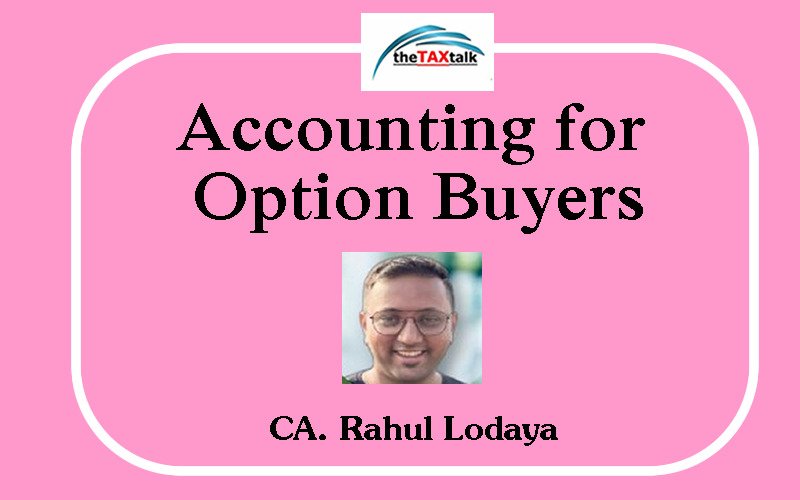![]()
Accounting for Option Buyers
Author
CA. Rahul Lodaya
Growth at a geometric progression is very addictive!!! And as I recall the days when I initially started to learn about option buying, the introduction to this concept was given as “place a bet on Rs 100 just by risking Rs 10”. How lucrative an earning opportunity does this sound to be!!!
And then as I dived deeper into these, I realized that Option Buying has its own intricacies & is an attractive & sweet bait to lose money if not traded well.
Nevertheless, I am here to discuss the aftereffects of Option Buying. Accounting for option buyers is something that this write-up shall cover.
EXPLANATORY NOTES- The coverage of an option buyers contracts in the market is all a play of choosing the right strike price & the right entry point. In a market that is unfavorable from an option buyer’s perspective as time is the biggest enemy what an option buyer faces in the market. However, the loss of a buyer is restricted to the premium prevailing on the ticker as & when he is entering the contract. Noteworthy point is that Option Buyer has to discharge the option premium, upfront in cash only. Collaterals are not allowed, as are allowed for option sellers. For this very reason, even the marked to market margins are not initiated for option buyers as the entire amount is paid up front.
The system explained below is applicable to both intraday as well as positional trades executed.
SYSTEMS SETUP – The system for accounting for option buyer would not involve the margins, like how it had been done for the futures contracts. However, it has its own set of principles to be followed.
Ledgers to be created in the books-
Account Name |
Head of Account |
Broker’s Account |
Current Asset |
Bank Account |
Current Asset |
Brokerage & Other Charges |
Direct Expenses |
Options Control Account |
Current Asset |
Option Premium Entry Account |
Purchase Account |
Option Premium Exit Account |
Sales Account |
Profit on Option Trade Account |
Current Asset |
Loss on Option Trade Account |
Current Asset |
ACCOUNTING FOR LONG OPTION CONTRACTS –
Assumptions for simplicity purposes –
-
Trader has an overdraft facility from the banker.
-
The option contracts are taken as a single unit, even though the exchanges trade options in lots.
-
Brokerage is paid only on settlement
Trade No 1 – Long Call of Nifty 17,100 for March Expiry trading at Rs 200. Position squared off, same day at Rs 250.
Debit A/c |
Credit A/c |
Reason |
Amount |
Option Premium Entry Account |
Options Control Account |
Entering the contract |
200 |
Options Control Account |
Option Premium Exit Account |
Exiting the contract |
250 |
Brokerage & Other Charges |
Broker’s Account |
Brokerage charged |
5 |
Profit on Option Trade Account |
Options Control Account |
Booking Naked profit |
50 |
Broker’s Account |
Profit on Option Trade Account |
Booking a receivable from broker |
50 |
Trade No 2 – Long Put of Nifty 17,500 for March Expiry trading at Rs 340. Position squared off the next day at Rs 300.
Debit A/c |
Credit A/c |
Reason |
Amount |
Option Premium Entry Account |
Options Control Account |
Entering the contract |
340 |
Options Control Account |
Option Premium Exit Account |
Exiting the contract |
300 |
Brokerage & Other Charges |
Broker’s Account |
Brokerage charged |
5 |
Options Control Account |
Loss on Option Trade Account |
Booking Naked Loss |
40 |
Loss on Option Trade Account |
Broker’s Account |
Booking a payable from broker |
40 |
Trade No 3 – Long Call Nifty 18,500 for April Expiry trading at Rs 70. Position open as on 31st March, value of call at Rs 60 on that date.
Debit A/c |
Credit A/c |
Reason |
Amount |
Option Premium Entry Account |
Options Control Account |
Entering the contract |
70 |
Options Control Account |
Loss on Option Trade Account |
Booking unrealized Loss |
10 |
Intentionally left blank
Effects of all 3 trades –
Particulars |
Trade 1 |
Trade 2 |
Trade 3 |
Total |
Option Premium Entry Account |
200 |
340 |
70 |
610 |
Option Premium Exit Account |
250 |
300 |
550 |
|
Options Control Account |
-200+250-50 |
-340+300+40 |
-70+10 |
-60 |
Brokerage & Other Charges |
2 |
2 |
0 |
4 |
Broker’s Account |
-2+50 |
-2-40 |
6 |
|
Profit on Option Trade Account |
50-50 |
0 |
0 |
|
Loss on Option Trade Account |
0 |
-40+40 |
-10 |
10 |
Rationale behind using control account & separate profit & loss accounts –
The control account serves as an indicator to disclose the position & exposure open in the market. On observing the table above, for every closed trade, the control account gets closed which clearly means that the trades still active in the market are captured.
Profit Account & Loss Account are simply running tools to determine the options turnover under the Income Tax Act. The simple mechanism to calculate options turnover under this system of accounting, on any given point of time is –
(Sum of Debits in Profit Account + Sum of Credits in Loss Account – Closing Balance of Profit Account – Closing Balance of Loss Account) + Sum of Option Premium Exit Account
Drawing up the financial statements
Balance Sheet (extract)
Capital |
Rs |
Asset |
Rs |
Options Control Account(Open Positions in Option) |
60 |
Profit & Loss (Loss Position) |
64 |
Loss on Option Trade Account (Provision for Losses) |
10 |
Broker’s Account |
6 |
Total |
70 |
Total |
70 |
Profit or Loss Statement (extract)
Expense |
Rs |
Income |
Rs |
Option Premium Entry Account |
610 |
Option Premium Exit Account |
550 |
Brokerage & Other Charges |
4 |
||
Gross Loss |
-64 |
||
Total |
550 |
Total |
550 |
EASE OF COMPLIANCE –
How to arrive at the futures turnover for Income Tax purposes?
The guidance note on tax audit quotes that the turnover shall be the sum of absolute profits & absolute losses along with the “sell value” of premium in initiating/squaring off an option transaction. The working is as under –
Particulars |
|
Rs |
Sum of Debits in Profit Account |
+ |
50 |
Sum of Credits in Loss Account |
+ |
50 |
Closing Balance of Profit Account |
– |
0 |
Closing Balance of Loss Account |
– |
10 |
Sum of Option Premium Exit Account |
+ |
550 |
Options Turnover |
|
640 |
This system accounts for the unrealized gains/losses but facilitates the ease of turnover calculation from taxation perspective. Broker’s report is majorly compliant from a taxation point of view but could create intricacies in drawing up true & fair books of accounts.
Why I chose this system of Accounting?
-
Easily reconstruct trades
-
Keep track of compliances from taxation perspective
-
Can be easily accounted with broker’s note & need not wait for the broker’s report
-
Keep track of the open positions at a given point of time.


